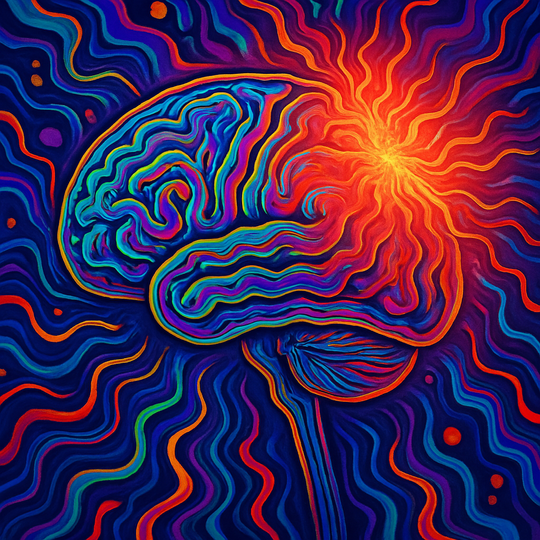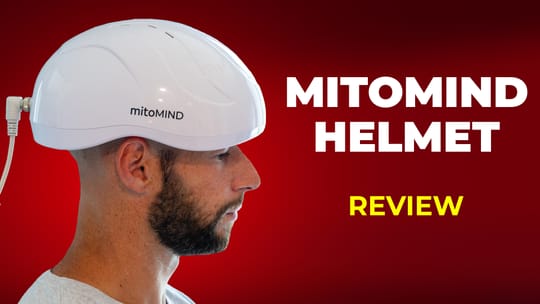Post-Traumatic Stress Disorder (PTSD) is increasingly understood well in the last few decades. PTSD is a response to a traumatic event that has both a physical and mental basis. Treatment options have become far better in the last decade or so, especially with some new psychedelic and non-psychedelic options for countering it (1; 2; 3; 4; 5; 6; 7; 8).
Today I'll take a slightly different perspective. I'll first explain what causes PTDS and why it develops. Then I'll explore the promising light therapy for PTSD options. Most of the research has been carried out on animals here, and I'll explore the implications for humans.
After the summary below, let's start with the basics though:
Red and near-infrared light, here, are primarily focused on preventing or reducing PTSD symptoms post-trauma. Human studies to validate these findings are needed.
Other light therapy applications, such as blue light for regulating circadian rhythms, already support existing PTSD treatment and are best used in the morning.
The Causes And Complexity Of PTSD
PTSD is getting more and more attention nowadays. And the causes and complexity of PTSD are extensively studied (9; 10; 11; 12; 13). In the past, such as with the soldiers fighting on the front on World War I, what is now called "PTSD" was called "shellshock" and was generally considered a form of weakness.
Nowadays, PTSD is considered a response to trauma that can happen to anyone. Still, there's disagreement about the classification of PTSD and what exactly causes it. The reason for that difficulty is that different people can have different responses to the exact same event (9).
For instance, after a devastating car crash, one person may develop PTSD while the other may not. The same is true for sexual abuse, violence, extremely chronically stressful situations, wars, accidents, and other life-changing events.
The result of PTSD is often a great psychological, economical, and other burden to both the individual and society in general. Structural changes occur, such as in brain physiology (10). Pharmaceutical interventions also play a major role in managing PTSD. Researchers write:
"Problems which are needed to be considered in case of PTSD like ongoing trauma, abusive or bad relationships. Various drugs which are used for the treatment of PTSD include selective serotonin reuptake inhibitors (SSRIs) (citalopram, fluvoxamine, fluoxetine, etc.); tricyclic antidepressants (amitriptyline and isocarboxazid); mood stabilizers (Divalproex and lamotrigine); atypical antipsychotics (aripiprazole and quetiapine), etc. " (11).
Often, PTSD leads to re-experiencing the traumatic event or period over and over again. Also, people with PTSD often engage in avoidant behavior, to avoid triggering their emotional and thought patterns associated with the trauma. Nightmares and dissociation from yourself and your thoughts are other possibilities. Depression and anxiety - obviously - are almost always present. Daily life is subsequently affected because problems such as
"sleep and concentration, irritability, increased reactivity, increased startle response, hypervigilance" (13).
Many more people are affected by PTSD than you'd think (14; 15; 16; 17). During COVID - a stressful period for many - over 17% were affected in both COVID patients and the professionals helping them (14). Depending on your definition, 3-26% of people are affected in their lifetime in the USA (15). Worldwide, 3-11% of people are affected at any moment of time (16; 17).
So even if you're not affected by PTSD yourself, someone you know definitely is. Being able to counter PTSD and resolve it is therefore extremely important:
Current Treatment Options For PTSD
Cognitive Behavioral Therapy (CBT) helps people get more rational control of the interactions between their emotions, thoughts, and behavior (9). An estimated two-third of people with PTSD eventually resolve their issues with CBT. CBT is carried out in supervision with a therapist, such as a psychologist of psychiatrist.
Nevertheless, most people on this planet don't have access to CBT because of the training for aid workers and costs involved (9). Other therapies can aid in countering PTSD as well - here's what researchers write about the topic:
"Evidence-based psychotherapies are the first-line treatment of PTSD, with cognitive behavioral therapies, such as prolonged exposure, cognitive processing therapy, and eye movement desensitization and reprocessing having the largest body and highest quality of evidence." (12)
Nevertheless, the psychedelic and non-psychedelic drugs I started this blog post with - under strict medical supervision and paired with psychotherapy - offer a great profile for resolving PTSD (1; 2; 3; 4; 5; 6; 7; 8). More research is needed there though, although emerging research is extremely promising!
Different treatment options for PTSD can work (18; 19; 20; 21; 22; 23; 24; 25). There's no easy answer here as not everyone responds to treatments the same way. And not every PTSD case is the same, either! Simple exercise therapy may work really well, for instance, even up to lots of exercise to support other PTSD treatments (18).
Fortunately, many evidence-based interventions for PTSD exist (19). So the main issue is to get treatment. Early intervention after trauma is important as it may lessen or prevent the development of PTSD - a topic I'll come back to soon (19).
For instance, Eye Movement Desensitization And Reprocessing (EMDR) can give the thoughts and feelings a different meaning (20). Even though the science isn't fully supportive of EMDR, I've seen very good results in family and acquaintances with this intervention (26; 27).
Treatment options are often suboptimal simply because guidelines aren't up to date with the state-of-the-art PTSD treatment:
Most guidelines consider both psychological and pharmacological therapies as first-line in PTSD. All but one guideline recommended cognitive behavioural therapy (CBT) as first-line psychological treatment, and selective serotonin reuptake inhibitors (SSRIs) as first-line pharmacological treatment. Most guidelines do not mention the targeted treatment of nightmares as a symptom of PTSD. Prazosin is discussed in several guidelines for the treatment of nightmares, but recommendations vary widely (21).
Simpler pharmaceutical interventions such as plain cannabis or oxytocin may work too though (22). Such interventions can potentially prevent the fear memory from being formed. Combining therapies, such as psychotherapy and pharmaceuticals, nevertheless works best according to the latest evidence (25).
And, the good news is that red light therapy may be added to that mix of therapies, perhaps eventually when more research on humans is carried out:
Red And Near Infrared Light Effects On PTSD
The biggest concern right now is that there are only four studies on red light therapy for PTSD - and all of these are animal studies (28; 29; 30; 31). Hence, the value of the research is limited until these results are confirmed in humans.
Three out of four animal studies have positive outcomes. Here are the study characteristics:
- The first 2023 study uses 810nm transcranially, in rats (28). The light was applied to prevent PTSD from developing, after the rats were hurt with an inescapable electric shock to their foot. When the 810nm was pulsed at 10 Hz, it led to superior results in the rats. Anxiety and freezing behavior were reduced. Brain changes also occurred in the rats. These results imply that 810nm pulsed light may prevent traumas from developing into full-blown PTSD, although more research is needed.
- Secondly there's a 2021 study in rats as well that doesn't have a positive outcome (29). A transcranial laser was used. The poor rats were exposed to a low-level blast once daily for three days as a traumatic event. Some of the rats didn't receive a blast and some of the rats didn't receive a laser treatment. The group receiving the blast and the laser treatment were exposed to 808nm light for 5 minutes, 5 times weekly for 6 weeks total. The red light therapy didn't work here and anxiety was even worse. The problem here is that the full text of the study doesn't describe the dosing in J/cm2 (32). With that information, I may have been able to draw an inference based on the dosing.
- Then, a 2021 study where red light therapy prevented the fear memory impairment development related to PTSD (30). Here the light therapy was applied directly after the traumatic event and only 1 therapy session was used. The result was that fear around the occurence was less and PTSD risk decreased. This outcome is very promising to test in humans - insofar possible - to prevent PTSD from developing in the first place. The problem is that in humans, you're often confused and shaken after a traumatic event, and light therapy is the last thing on your mind. Also, we don't have human studies to confirm these outcomes in rats. The 808nm wavelength was used (33). The power output was 350 mW/cm2 for 2 minutes.
- Lastly, there's a 2021 study where rats were exposed to water trauma (31). After the traumatic experience, the rats had swimming sessions the next days. Some rats received 808nm light at 25 mW/cm2. Here once more, the red light therapy prevented the PTSD from developing. Gene expression (which genes are activated) changes in brain areas such as the hippocampus (important for memory) and amygdala (important for emotional regulation). Red light therapy also boosted ATP production, which plays an essential role in energy.
Although these are rat studies, the outcomes are extremely impressive. Keep in mind that the red light therapy needs to be applied immedatiately after trauma. Researchers write that:
"Since we applied [Photobiomodulation (PBM) or red light therapy] as early intervention during the consolidation45 and reconsolidation46 windows of the trauma-associated memories, whether delayed PBM treatment applied outside these windows can generate the same treatment effect is as yet unknown and warrants further investigation." (34)
Again, I'd like to see more human research on this topic.
The Role Of Light Therapy In Mental Health
I've written about red light therapy for mental health before, such as red light therapy for depression and brain red light therapy. I'll only briefly cover the topic here.
Overall, red light therapy has a decently strong effect on:
- Depression (35; 36; 37). Even Major Depressive Disorders (MDD) and Treatment-Resistant Depression (TRD). are affected. Generally red light therapy is best used as a supportive tool. In many studies, the effect of red light therapy is as strong as antidepressive medication (although I don't recommend replacing your medication without talking to your doctor - this blog doesn't contain medical advice!)
- Anxiety (38; 39; 40). Again, red light therapy is best used as a supportive tool.
- Many other brain conditions - again, I take a real deep dive in everything from Alzheimer's Disease to ADHD to a stroke in my brain red light therapy blog post deep dive!
Overall, red light therapy for mental health is extremely promising. I'd like to see more research here for people with existing or hart to treat PTSD and get data on how red light therapy helps symptoms like fear, anxiety, depression, poor executive function (such as planning) and more.
Light Therapy Applications And PTSD
Fortunately, there are more options in countering PTSD. It turns out that if you manage your circadian rhythm properly, getting bright light exposure can be a game-changer (41; 42; 43).
To use this effect, you'll need blue light exposure in the morning. Morning sunlight is arguably the best by far, but, some people don't have this option available because they've got very dark winters at their location or because they're working at that time.
In such cases, using a red light therapy panel that emits a decent amount of blue light is an asset. A decent option here is the PlatinumLED BioMax 900, which emits some blue light - Alex Fergus reviewed that panel here:
And then, if you want a lot of blue light exposure - which I recommend in the morning if you don't have an alternative, consider the LightpathLED Diesel Blue Combo panel - Alex reviewed the regular version here:
The PlatinumLED BioMax 900 has only a few % of LEDs allocated towards blue light but for the LightpathLED Diesel Blue Combo panel it's 33%. Then, there's a Lux Vital product by Chroma which Alex hasn't reviewed yet, but which is more portable than a panel and arguably has tons of different types of blue light for the best effects.
You can grab these panels here with a discount:
- PlatinumLED BioMax panel - use the link for a discount to be generated
- Lightpath LED Diesel Blue Combo - use code ALEX and get 5% off
- Chroma Lux Vital - discount code ALEX saves
So what does blue light do? First, PTSD becomes more treatable and the response increases by more than 33% (41). Secondly, symptoms like depression may decrease (42). Thirdly, sleep improves and you may have less fear and symptom severity (43; 45).
The amygdala, the emotional center of the brain that may be enlarged and quicker to trigger in PTSD, may be less reactive (44; 45). The goal here is to expose your eyes to bright blue light in the morning. If you'd like more information, check my guide on blue light therapy.
To be clear, you don't necessarily need laser light therapy for PTSD. The LEDs I've mentioned are fine!
Conclusion: Hopefully, We'll See Tons Of Research On Light Therapy For PTSD!
As you can see, light therapy for PTSD is just getting started. And, both red and blue light therapy applications are already very promising. Red light therapy when applied around the traumatic event may prevent PTSD from forming. Blue light therapy in the morning may improve fear, insomnia, and other symptoms. Of course, both can be used together for the best effects.
Now, it's time to wait for more human studies. Unfortunately, it's not easy to test for this, as most people don't know that they've got PTSD after a life-changing traumatic event. Also, hopefully, we'll get good results with people who have had PTSD for a longer period of time as well - in both animal and human studies.
Led light therapy used for PTSD has a bright future ahead!
Frequently Asked Questions
Lastly, a few frequently asked questions on the topic:
Does strobe light therapy for PTSD work?
Yes, strobe light therapy for PTSD is the same as the EMDR which I talked about earlier in this blog post. EMDR has a decent track record, even though some scientists think EMDR is pseudoscience.
Can I use EMDR therapy on my own?
Contrary to light therapy for PTSD, you can't use EMDR on your own - you'll need a psychologist, psychiatrist, or similar to administer the therapy to you. The EMDR isn't the only "ingredient" of the therapy - the preliminary psychotherapy and after therapy are important too.
Should I use color light therapy for PTSD?
There's no need to see "color light therapy" as separate to the different types of ligh therapy I discussed above. So, red light therapy or blue light therapy are all part of "color light therapy" - the latter is just a different name for the same input!
This is a post by Bart Wolbers of Lighttherapyinsiders. Bart finished degrees in Physical Therapy (B), Philosophy (BA and MA), Philosophy of Science and Technology (MS - with distinction), and Clinical Health Science (MS), has had training in functional medicine, and is currently chief science writer.
Items Mentioned
- PlatinumLED BioMax panel - use the link for a discount to be generated
- Lightpath LED Diesel Blue Combo - use code ALEX and get 5% off
- Chroma Lux Vital - discount code ALEX saves
Found This Interesting? Then You Might Like:
- Discount Codes, Deals & Recommendations - Red Light Therapy
- Red Light Therapy Wavelengths Benefits: The Ultimate Guide
- Does Vielight Work? A Close Look At The Spectacular Vielight Science
- Neuradiant 1070: Red Light Therapy For Your Brain?
- Why Dr. Terry Wahls Advocates Red Light Therapy for MS
- Red Light Therapy For Depression: A Potential Solution
- Red Light Therapy For Upgrading Your Brain Health









